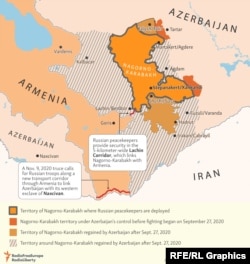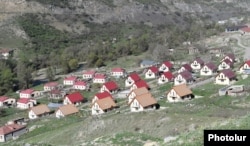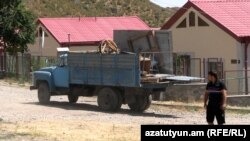AGHAVNO/ZABUX, Azerbaijan -- Posters and children's drawings are peeled off walls and packed away. Books and other objects are boxed.
All the school material is to be shipped out from the village in a strategic strip of land adjacent to breakaway Nagorno-Karabakh. That deemed not worth salvaging is burned.
Under terms of a cease-fire deal that ended the short war in and around Nagorno-Karabakh in 2020 between Azerbaijani soldiers and ethnic Armenian forces, Armenians are due to hand control of the village they call Aghavno, but Azerbaijanis name Zabux, over to Azerbaijani forces.
The village is located along the Lachin corridor, a strip of land that connects what Azerbaijanis call simply Karabakh to Armenia and which is now under control of Russian troops deployed to the region in the wake of the conflict two years ago.
Now, Azerbaijan has built a new roadway -- just south of the old one -- that will allow them to retake control of ethnic Armenian villages within the strip.
The lack of such an alternative road in 2020 delayed the transfer of Lachin. And with the new road now largely in place, the transfer is expected to go ahead although there has been no official announcement from Baku.
However, people living in the region have been urged to vacate their homes before August 25 by the de facto local ethnic Armenian authorities, although Baku has not issued any calls for them to leave.
Ethnic Azeris fled villages in the Lachin region in 1992, when ethnic Armenian fighters occupied it. Even 30 years later, some still hope to return to their homes. But many ethnic Armenians in the village they call Aghavno are defiant, some saying they will remain until forced out.
"We are thinking of taking the children out, but we adults will stay until the last day, until the last hour, we will see how they will carry out the purchase and sale, or whatever else you call it," Anush Arakelian recently told RFE/RL's Armenian Service.
WATCH: Thirty years after being displaced amid conflict from their native village, some Azerbaijanis still dream of returning to Zabux.
The town's current fate is linked to the conflict in 2020, when more than 6,500 people were killed in 44 days of fighting. It ended with a Russian-brokered deal under which Armenian forces withdrew from swathes of territory they had occupied since 1992-93.
Moscow has sent some 2,000 troops to the region, deployed to the areas of breakaway Nagorno-Karabakh still held by ethnic Armenians after their forces withdrew.
Part of that force was deployed along the Lachin corridor. Once the new road opens, that force is supposed to move there too, ostensibly to guard it.
The terms of the cease-fire stipulated that a plan to build a new road to replace the current corridor be presented within three years, bypassing Lachin city, Zabux, and Sus, as they are called by the Azerbaijanis.
However, Azerbaijan is far ahead of that schedule, announcing on August 11 that it had completed its estimated 20-kilometer stretch of a 32-kilometer road.
There is some question over when the road will be officially opened, as Armenia has just started construction on its several-kilometer section of the new road, it was reported on August 11.
Whatever the date, Mariam Hakobain told RFE/RL that she will stay to the very last day, when the Russian troops leave. "We as a nation stood up and committed suicide," she said, adding that only nine families wanted to stay elsewhere in Nagorno-Karabakh.
"We are crushed," Hakobian said.
Anush Arakelian, an Armenian-language and literature teacher, says it's become a virtual ghost town with what activity there is, largely cars driving in and shipping out personal effects.
Lida Smbatian can't imagine abandoning her home, especially the strawberries, vegetables, and flowers she has tended in her garden since moving there in 1994. "All my joy was in my strawberries, in my strawberry field, in the grapes. See, the tomatoes are ripe now," she lamented in comments to RFE/RL's Armenian Service.
To help them find new homes, the Armenian government has promised each family 10 million drams (around $24,700), a sum many say won't buy much in Armenia. That financial aid is supposed to come in the form of a voucher.
Ethnic Armenians in the region, however, have said they've been told they will only get that voucher if they leave their homes as is. That is, with no visible damage, as happened in late 2020 when several homes were damaged by their homeowners before being vacated in the Kalbacar district ahead of a deadline dictated by the Russian-brokered cease-fire.
Footage has emerged showing what appears to be an ethnic Armenian in Aghavno setting alight his own house, a video that has gone viral on YouTube. A series of fires have also been reported along the road in Lachin in recent days. Although it is unclear what caused the blazes, Azerbaijanis have been quick to blame fleeing Armenians for them.
While the deadline has stirred dread among the ethnic Armenians living there, it has rekindled hope for the ethnic Azerbaijanis who were displaced 30 years ago, some now hoping to return to Zabux. "We escaped under dire circumstances. We couldn't find a car. We got into one car, then another. Without clothes. Everything was left to the Armenians," said Sitara Mammadova, now 90 years old. "We couldn't take anything. We came here and somehow coped," explained Mammadova, who now lives in a former boarding house outside Baku, adding that she still hopes to return to Zabux.
The conflict over the region erupted in the late 1980s in the waning days of the Soviet Union. All-out war ended in 1994, with more than 30,000 people killed and more than 1 million people displaced, mainly ethnic Azeris.
At the end of the fighting in 1994, ethnic Armenian forces were in full control or partial control of Nagorno-Karabakh and seven adjacent districts. In the 2020 fighting, Baku took back the seven districts as well as part of the Karabakh territory.
Isaq Mamishov is another displaced Azerbaijani yearning to return. "There are some [Azerbaijanis] who lost their entire family [in the 1990s conflict]," he told RFE/RL's Azerbaijani Service in July.
"How can their children live side by side with Armenians again? Yes, it is true that we are a peace-loving nation.... And if our president gives an order, our nation will go for it. Even if it's hard, we will accept that, because we all love our president. We will follow what he says. But it won't work," Mamishov added pessimistically.
Azerbaijani President Ilham Aliyev, whose popularity was boosted by the 2020 conflict to levels he has rarely enjoyed during his nearly two decades of authoritarian rule, has suggested those remaining in villages in Lachin were "war criminals."
"We hear news coming from there that someone says they will stay and will not leave. It is their business, but they are war criminals. They should not test our patience. Let them leave by their own will, we don't care where they go," Aliyev was quoted as saying by Azerbaijani media on August 12.
Azerbaijanis fled Zabux during the first war in the 1990s, when it came under control of Armenian forces along with the rest of the surrounding Lachin district. Renamed Aghavno it was rebuilt with financial backing from Armenian diaspora organizations and populated by Armenians, some from Armenia and others from Armenian communities in Syria and Lebanon.
As the handover looms, tensions have been building on the two countries' shared border since May 2021, when Armenia protested what it described as an incursion by Azerbaijani troops into its territory. Azerbaijan has insisted that its soldiers were deployed in areas where the border has yet to be demarcated.
Sporadic clashes have taken place in the last year, the latest coming on August 3. De facto ethnic Armenian military leaders said drone attacks carried out by Azerbaijani forces killed two of their troops and wounded another 19.
Russia accused Baku of violating the shaky truce, while the United States and the European Union urged an "immediate" cessation of hostilities.
Since Russia's invasion of Ukraine, its military mission to the region has faced even greater challenges than before, with criticism coming from both sides. In an apparent bid to improve its image, the Russian mission's head invited several local activists and politicians for a rare meeting on August 4 to discuss the recent incidents, the International Crisis Group noted.
Despite the uptick in tensions, back in her village, Smbatian expresses hope that her garden -- and its harvest -- can be a token of friendship to its new occupants. Vegetables from the garden should be ripe for picking sometime in the fall, and the home will likely be occupied by Azerbaijanis, Smbatian explained.
"I don't know who will eat it or whether they will be cursing or blessing us."



